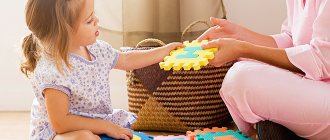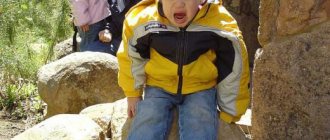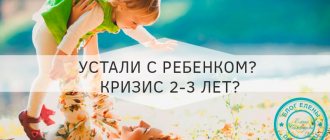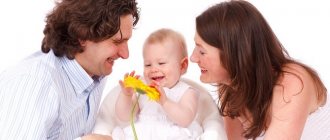What is the revitalization complex in psychology?
The revival complex is a manifestation of motor activity and expression of emotions by a child when a significant adult appears within the reach and visibility of him. The baby reacts to its parents from about the third week of life. Physiologists believe that with the emergence of the revitalization complex, the baby enters a new stage of life - infancy.
Children are born with a basic set of reflexes, and over time, developing new ways of responding to external events, they adapt to unfamiliar living conditions. Psychologists express the opinion that the baby’s initial adaptation to society is successful if he is in the 3rd week:
- able to focus attention on people, objects, sounds;
- freezes when parents or adult relatives appear;
- responds with a smile to kind words;
- can express joy with enthusiastic sounds.
Story
The concept of “autism” was first described in 1911 by Eugen Bleuler, but it was considered in the context of schizophrenia, as one of its symptoms. Translated from Latin, it means “abnormal narcissism.” With this term, the psychiatrist tried to indicate the patient’s withdrawal into his inner world, isolation from the intrusive interference of outsiders, and separation from reality. In its modern interpretation, it began to be used at the suggestion of Hans Asperger, after whom one of the autism spectrum disorders, Asperger syndrome, was named.
The concept of “early childhood autism syndrome” was introduced into psychiatry by Leo Kanner. In 1943, he introduced the term “autism” into a completely new context by describing the stories of 11 children and diagnosing them with infantile autism. He pointed out that this condition is markedly different from schizophrenia in children. In the picture of the disease, he noted the presence of symptoms such as stereotypical movements and echolalia. One of the variants of ASD, Kanner syndrome, was also named in honor of Leo Kanner.
At what age does the complex form?
With normal development of the baby, initial signs of emotional revival can be noticed already in the first month of life. At the age of two months, the baby confidently looks for a significant adult in the room, carefully looks at faces, and in response to the voices of loved ones addressed to him, he smiles, moves, screams and gurgles. The revival complex during this period is characterized by the following manifestations:
- smile;
- freezing and a long concentrated gaze that the baby lingers on a loved one;
- active motor revival: the baby turns his head, throws up his arms and legs, bends his back;
- vocalization: hooting, humming, abrupt vowel sounds.
The baby performs all these actions simultaneously, which is why they are called a complex.
.
Stages of the revitalization complex
If parents have created a favorable psychological environment for the baby at home, then the revitalization complex will appear in a timely manner. A favorable environment is considered:
- harmonious alternation of silence and peace with moments of active wakefulness;
- a sufficient amount of attention and affection;
- exclusion of severe psycho-emotional shock in the first month of life.
If your baby doesn't react to a colorful rattle, don't get upset ahead of time. You need to be patient, because in just a couple of weeks your heir will appreciate all the toys. Through the revitalization complex, the baby tells you that he is ready to explore the world around him.
The complex of emotional revival occurs in several stages:
- New reactions appear, which psychologists call the revival complex (freezing, focusing on the adult’s face and voice, smiling, enthusiastic screaming, physical activity).
- The baby begins to distinguish the voices of others and recognizes the mother's voice.
- About two weeks after the end of the newborn period (this period lasts from the first day of life until the appearance of the revitalization complex), the child focuses his attention on attractive colorful objects and can track movement with his eyes.
- At the beginning of the third month of life, the baby reacts emotionally not only to the mother’s appearance and voice, but also to touch and to the feeding process. When mom is nearby, the baby is calm and happy.
- By the end of the third month of life, the child’s behavior takes on more complex forms; during this period he is already able to distinguish loved ones from strangers.
If the baby is in good conditions and psychologically develops in accordance with the norms, then at 4-5 months the revitalization complex will already include the first skills of self-regulation, that is, the baby will learn to control his mood.
Speech, intelligence, worldview
Children with autism have impaired perception of the overall picture of the world. They analyze the object not as a whole, but divide it into details. They are interested in the car not as a form of transport, but only because its wheel moves.
Such children are not characterized by the desire to understand the world, study the properties of an object, its purpose. They choose attractive elements for themselves and follow them. Cognitive questions “why, why” lag in time.
Autistic children have a hard time getting interested in toys, but they focus on sensory stimuli. For example, a baby loves classical music so much that already at one year old he finds the right record in a stack and puts it in the player.
However, what is amazing is the ability of such children to remember what they, looking from the outside, do not pay attention to, hear what they do not listen to, see what they do not look closely at. When it is subsequently possible to establish verbal contact with them, the children talk about many things that, as it seemed, did not interest them.
As for memory, it can be said to be selective. They remember very well what is significant to them: the situation in the apartment, habits in the family, etc. Therefore, any violation of the routine causes indignation in them. Children are also good at remembering events that made them feel afraid.
A special feature of little autistic children is mechanical memory. They perfectly remember poetry, reproduce complex drawings and songs.
The speech of autistic children also has its own characteristics. In infancy, they are not characterized by humming and babbling. They appear very late. The first words are spoken on time, but these are not the usual “mother”, but completely different words that are not used for direct communication.
Many children's speech is either very poor, with a small vocabulary, or practically not developed at all. They hum, smack, and speak their own language. The words are incoherent and may use expressions taken from the cartoons they have watched.
Echolalia is observed - repetition of words addressed to the autistic person. Sometimes very complex expressions are repeated, but purely automatically, without understanding the meaning. There is a reversal of pronouns; when a child with ASD is asked what your name is, he answers: “Your name is Petya.”
The meaning of the speech of an autistic child is understandable only to close people, since he operates with abstract concepts. For example, when mom is angry, she answers her: “Have mercy, madam.”
Even if the baby’s speech is quite well developed, and his vocabulary is very rich, he is still incapable of dialogue. He speaks only about what interests him, in the form of a monologue, while the intonation of his statements suffers.
Autistic people easily learn foreign languages. But, as teachers note, they also master their native language as a foreign one.
In general, speech with RDA is also stereotypical. It is often incomprehensible to others, as it expresses the personal interests of its bearer. Spontaneous speech used in communication is poorly developed; children better perceive indirect speech addressed to others. They can speak clearly and without hesitation, using complex expressions, in the form of a monologue or echolalia, but they stumble, get confused and speak blurredly when trying to start a dialogue.
Maximum activity
We have found that the baby gradually masters the skills of communicating with close adults, and this ability will be the main activity of the first half of life.
Psychologists say that the revitalization complex directly depends on the level of satisfaction of a small child’s needs for emotional communication. The peak manifestation of the revitalization complex is the baby’s age from 3 to 4 months, after which it transforms into more complex forms of behavior, therefore it is during this period that parents are recommended to accompany all their actions with verbal comments.
Classic autism
Autism is a disease whose core symptoms are impaired social interaction. That is, such a child has an absent or very poorly developed level of communication with others, and sometimes with close people.
Difficulties in communication manifest themselves both verbally and non-verbally. The child’s speech may be practically undeveloped or its accelerated development may be noted. He may have a huge vocabulary, but cannot engage in dialogue.
Nonverbal disorders are associated with difficulties in establishing visual contact, originality of postures, facial expressions, and gestures. An indicative criterion is the lack of empathy, that is, the ability to empathize with other people, understand their feelings, show care, compassion, be sad or rejoice with them.
The classic triad of RDA symptoms are:
- low level of social interaction, mutual communication;
- meager sphere of interests;
- stereotypical movements.
The disease manifests itself up to 3 years of age. Its first signs can be detected in the first year of life, but most parents attach importance to them when the child is 2 years old and older.
Signs of autism remain with a person throughout life to varying degrees. To date, scientists have not yet found a way to completely cure it.
Autism is associated with a disorder of the brain.
Research confirms that the development of the nervous system is influenced by the immune system even in the early stages of embryonic development, or, more precisely, by its insufficient function.
There is a theory that autistic individuals have an underdeveloped mirror neuron system. These cells are excited during motor activity, as well as when observing the activity of other people. For this reason, such people do not have the opportunity to adopt the behavior of others and monitor them.
Despite the large amount of research into the causes of the disease, the question of its nature remains open. Numerous theories reflecting on this problem do not provide a clear and complete answer.
What should a four-month-old baby be able to do?
Thanks to the correct manifestation of the revitalization complex, by four months the baby:
- responds to his name;
- is interested in his body (looks at arms and legs, touches his face and hair);
- has the rudiments of object-manipulative activity (play, work, drawing);
- looks at himself in the mirror;
- recognizes familiar objects (is surprised if they disappear and is happy when they are found);
- can sit with support, keeping the head straight;
- knows how to roll over from back to stomach and back;
- clapping hands;
- pushes off the surface with the toes;
- able to identify simple emotions (joy, sadness, fear, interest, surprise, disgust).
What happens to the child after the emotions of revival?
The revitalization complex in psychology is the beginning of a new stage in the development of an infant, whose task is to understand the surrounding world.
After the revival complex appears, the baby:
- feels the need to move;
- seeks to interact with adults;
- psychologically well;
- responds with a reaction to a visual and/or auditory stimulus.
The meaning of the appearance of the revitalization complex. When should parents sound the alarm?
By six months, it becomes clear why the baby needed a revitalization complex: the child consciously tries to interact with the adult environment, using various intonations, postures, facial expressions and gestures, and gets acquainted with new objects and people every day.
The level of the infant’s personal development will directly depend on the age at which the revitalization complex was discovered and whether it was clearly expressed. If some structural link of the complex was weakly manifested or completely absent; if the complex appears untimely or is protracted, this is a signal to the parents to show the baby to the doctor, since such moments can negatively affect the child’s mental development. Only a qualified specialist can identify the cause and choose a method to eliminate it.
Summing up the first year
So, the baby is one year old. The most important stage in life has been passed! These 12 months, in terms of the physical and psycho-emotional development that the child has gone through, cannot be compared with any other year of life. From a helpless creature, he turned into a little man who copes with a whole set of operations, with his own character, preferences and inclinations.
Physical development:
- Stands up and sits down independently;
- Walks independently or with support on one side;
- Chews solid food;
- Performs actions previously learned while playing with toys.
Psycho-emotional development:
- Says several words (sometimes in a simplified version), in addition to “mom” and “dad”;
- Expresses displeasure at the word “impossible”, at the harsh tone of an adult’s voice, at the inability to perform the desired action;
- Knows the names of several adults and children; shows body parts;
- Looks questioningly at an adult when there are difficulties or in unfamiliar situations;
- Behaves differently with different people (mom, dad, grandma, strangers);
- Worried when meeting and saying goodbye;
- Has clearly defined interests, favorite and least favorite activities, food preferences;
- Tries to participate in dressing (raises hands up, raises legs), washes.
At the age of one year, the child loves to show independence. This should be supported and developed further, for example, by inviting him to choose his own clothes for a walk, food for an afternoon snack, a joint game or an independent activity. If independence begins to manifest itself in the form of emotional outbursts, it is better to let the baby calm down (sometimes he will need your help with this too), and later explain what you wanted from him.
Advice from psychologists to young parents
Sometimes young parents neglect the baby’s need and desire to communicate, believing that only comfortable living conditions are important for the baby. And some parents simply do not know how to communicate with their child and do not want to learn this, believing that at this age children are not yet able to understand anything.
Psychologists advise new parents to appreciate every moment spent with their children. The correct development of the revitalization complex is provoked by affectionate words, stroking, kisses, and a smile.
Dear parents, it's simple! If the baby bursts into laughter in response to his mother’s kiss, then you need to kiss him again and again! If he hums invitingly, talk to him, sing a song. If the baby is in a good mood, it’s time to play with him, rock him in your arms or tickle him.
In our courses, experienced teachers talk about all aspects of psychology, including children's psychology. Such knowledge will help not only to master useful psychotherapeutic techniques, but will also provide the opportunity to acquire a new profession.
It must be remembered that emotional revival is a unique time in a child’s life, and the competent actions of parents during this period are extremely important.
Age norms and standards are only a guideline
Remember that so many factors play a role in the development of a child that the most picky specialist will not undertake to strictly assess his maturation in the first year of life.
The period for the appearance of certain skills can be extended in time from 2 to 6 – 7 months. For example, particularly active children may try to get on their feet as early as 5 months; those who, due to their temperament, are in no hurry, may begin to show interest in such activity only at the age of one year. If you think your baby is developing some skills late, don't be afraid to talk to your pediatrician: general practitioners have a lot of experience and knowledge about all the normal variations.
You can be sure that if from the first days of his life the child ate well and slept, was in the fresh air, received a sufficient amount of physical and emotional stimuli, was surrounded by the love and care of adults, was examined on time by a pediatrician and specialized specialists - to his On his first birthday he grew into a beautiful, healthy and happy baby!
List of used literature:
- Kazmin A.M., Kazmina L.V. Diary of child development from birth to three years. - Moscow: Publishing House "Cogito-Center", 2008.
- Lisina M.I. Communication, personality and psyche of the child. - Voronezh: Publishing house NPO "MODEK", 1997.
- Mukhina V.S. Child psychology. - Moscow: Publishing House "Prosveshchenie", 1985.
- White B. The first three years of life. - Moscow: “Pedagogy”, 1982.











